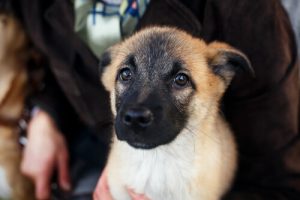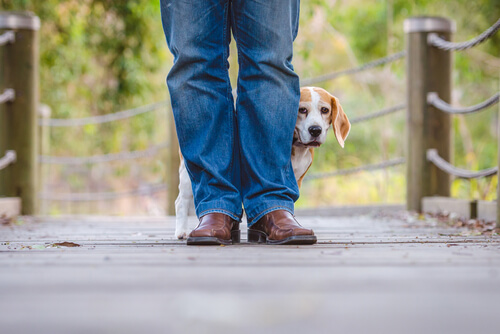Precautions for Dogs Afraid of Fireworks

Even though fireworks seem like fun for children, dogs that are afraid of fireworks have a very bad time. We are going to give you advice on how to help your pet during these complicated days.
How fear works
The fear of fireworks can be overcome, but it needs time and a competent teacher that knows how to help. A few days before the holidays, we can use a temporary solution that lets us get through the celebrations. We would need a solution that is especially focused on guaranteeing the safety of our pet and minimizing the effects of the fireworks.
When an animal is afraid, he has three options: flee, fight, or surrender. In the case of dogs, the first option is always to flee. However, in other situations the dog could try to fight, even if the fireworks are not a real enemy. When there is fear of fireworks we will almost always see a dog that wants to run away to his house.

Secure your house
We know that fireworks could get close and our dog could panic. Before anything else, we must guarantee his safety, and our house is the first place where he should feel safe.
We should block access to balconies and close the windows. Ever year there are stories of dogs that are afraid of fireworks. Some desperately throw themselves out the window, and suffer serious injuries or even die from the fall.
In houses with a yard, we must check the condition of the fences. If there are holes underneath or between the fences, the dog could escape. If the fence is low, it is even possible that he could jump over it. We could consider the option of not letting him out into the yard during those days.
Dangerous substances that a dog could bite or chew should not be within reach of those that are afraid of fireworks. Dogs release a lot of stress by chewing things. If he needs to nibble an object, it should not be toxic or dangerous.
A safe zone for dogs afraid of fireworks
We could create a safe zone inside our house that helps the dog get through these days. It should be a room or spot inside the house where nothing bad is going to happen to the dog. This area should act as a refuge from his fears, so it should have the following characteristics:
- It must be accessible 24-7. For example, if the dog hides inside the bathtub, the bathroom door must always be open. So when he takes shelter there, we must not force him to come out.
- If the dog does not choose the spot, we can guide him towards it. Many fearful dogs already have preferences for certain places in the house. However, if he wanders around the house when he’s afraid, we can create a safe zone and gently guide him towards it.
- It should be isolated from the outside. It cannot have open windows, and if possible, it should have the blinds down or the shutters closed. It should also be quiet. The less outside noise that can be heard, the better.
- When he uses the safe zone, we cannot kick him out. If the dog chooses to take shelter we must offer him water (panting is a sign of fear) or our comfort, but we cannot ask him to leave the area, let alone force him to leave it.
Change the walk route
We should check what noises there are during walks with the dog. If necessary, we should change the walking route. We can reduce the number of walks or the duration in case it’s necessary. There are times of the day when there are fewer noises, and we must take advantage of them.

It’s better to have a short and calm walk than a long one full of fear and distress. It is totally fine if we walk a shorter route or if we walk fewer times a day. Dogs that are afraid of fireworks will appreciate not being exposed to the noises on the street.
Fastening methods
With fearful dogs, it is key to review the fastening methods we use when taking them out. Harnesses are more secure than normal collars, and punishment collars only make the dog’s fear worse.
Everything that he wears outside should be in good condition. If we take the chance that the dog will pull on the leash when he hears a noise, we cannot risk that the leash will come apart or the buckle on the harness will get loose. The dog could start running around disoriented and not know how to get home. And if we live in an area with highways and traffic, his life could be in danger.
A new harness or leash is not expensive and could be the difference between a safe and lost dog. It is always worth it to replace his things if need be, even more so during these holidays.
Extreme cases
There are a few extreme cases of dogs with an intense fear. Some dogs become paralyzed or have such a bad time that they vomit or stop eating. Some even stop doing their business for hours or days.
These extreme cases should be examined by a veterinarian. If a dog is extremely afraid, it could become necessary to prescribe a tranquilizer– never a sedative– that helps him get through these days. It won’t make him forget his fear, but it will allow him to survive the celebrations.
Once the worst days are over, a canine behaviorist should see and evaluate the dog to help him face his fears. This is a treatment that can only be done under the supervision of a professional. Such intense fear compromises the well-being of the dog and should not be forgotten until the next celebration with fireworks.
Even though fireworks seem like fun for children, dogs that are afraid of fireworks have a very bad time. We are going to give you advice on how to help your pet during these complicated days.
How fear works
The fear of fireworks can be overcome, but it needs time and a competent teacher that knows how to help. A few days before the holidays, we can use a temporary solution that lets us get through the celebrations. We would need a solution that is especially focused on guaranteeing the safety of our pet and minimizing the effects of the fireworks.
When an animal is afraid, he has three options: flee, fight, or surrender. In the case of dogs, the first option is always to flee. However, in other situations the dog could try to fight, even if the fireworks are not a real enemy. When there is fear of fireworks we will almost always see a dog that wants to run away to his house.

Secure your house
We know that fireworks could get close and our dog could panic. Before anything else, we must guarantee his safety, and our house is the first place where he should feel safe.
We should block access to balconies and close the windows. Ever year there are stories of dogs that are afraid of fireworks. Some desperately throw themselves out the window, and suffer serious injuries or even die from the fall.
In houses with a yard, we must check the condition of the fences. If there are holes underneath or between the fences, the dog could escape. If the fence is low, it is even possible that he could jump over it. We could consider the option of not letting him out into the yard during those days.
Dangerous substances that a dog could bite or chew should not be within reach of those that are afraid of fireworks. Dogs release a lot of stress by chewing things. If he needs to nibble an object, it should not be toxic or dangerous.
A safe zone for dogs afraid of fireworks
We could create a safe zone inside our house that helps the dog get through these days. It should be a room or spot inside the house where nothing bad is going to happen to the dog. This area should act as a refuge from his fears, so it should have the following characteristics:
- It must be accessible 24-7. For example, if the dog hides inside the bathtub, the bathroom door must always be open. So when he takes shelter there, we must not force him to come out.
- If the dog does not choose the spot, we can guide him towards it. Many fearful dogs already have preferences for certain places in the house. However, if he wanders around the house when he’s afraid, we can create a safe zone and gently guide him towards it.
- It should be isolated from the outside. It cannot have open windows, and if possible, it should have the blinds down or the shutters closed. It should also be quiet. The less outside noise that can be heard, the better.
- When he uses the safe zone, we cannot kick him out. If the dog chooses to take shelter we must offer him water (panting is a sign of fear) or our comfort, but we cannot ask him to leave the area, let alone force him to leave it.
Change the walk route
We should check what noises there are during walks with the dog. If necessary, we should change the walking route. We can reduce the number of walks or the duration in case it’s necessary. There are times of the day when there are fewer noises, and we must take advantage of them.

It’s better to have a short and calm walk than a long one full of fear and distress. It is totally fine if we walk a shorter route or if we walk fewer times a day. Dogs that are afraid of fireworks will appreciate not being exposed to the noises on the street.
Fastening methods
With fearful dogs, it is key to review the fastening methods we use when taking them out. Harnesses are more secure than normal collars, and punishment collars only make the dog’s fear worse.
Everything that he wears outside should be in good condition. If we take the chance that the dog will pull on the leash when he hears a noise, we cannot risk that the leash will come apart or the buckle on the harness will get loose. The dog could start running around disoriented and not know how to get home. And if we live in an area with highways and traffic, his life could be in danger.
A new harness or leash is not expensive and could be the difference between a safe and lost dog. It is always worth it to replace his things if need be, even more so during these holidays.
Extreme cases
There are a few extreme cases of dogs with an intense fear. Some dogs become paralyzed or have such a bad time that they vomit or stop eating. Some even stop doing their business for hours or days.
These extreme cases should be examined by a veterinarian. If a dog is extremely afraid, it could become necessary to prescribe a tranquilizer– never a sedative– that helps him get through these days. It won’t make him forget his fear, but it will allow him to survive the celebrations.
Once the worst days are over, a canine behaviorist should see and evaluate the dog to help him face his fears. This is a treatment that can only be done under the supervision of a professional. Such intense fear compromises the well-being of the dog and should not be forgotten until the next celebration with fireworks.
This text is provided for informational purposes only and does not replace consultation with a professional. If in doubt, consult your specialist.







